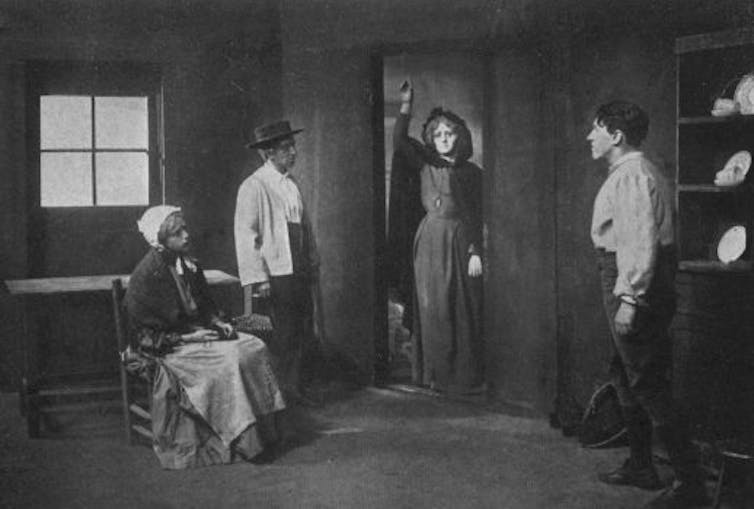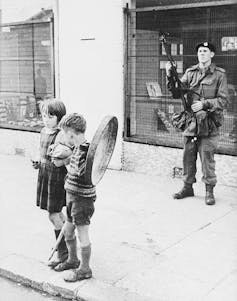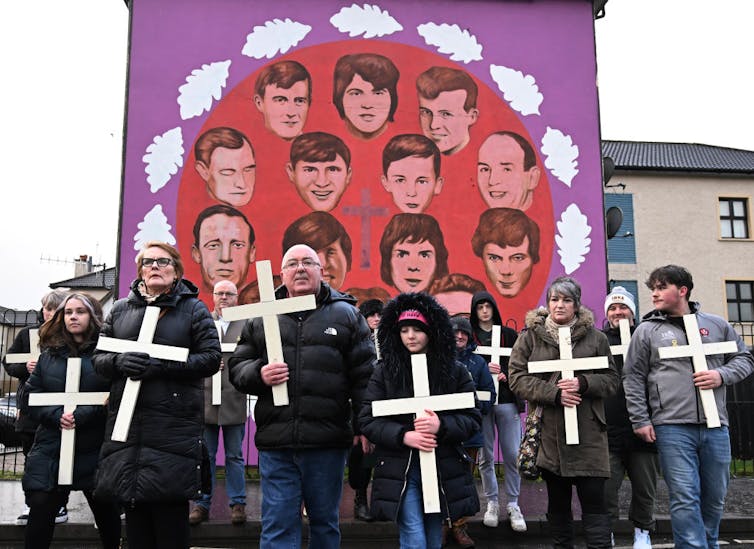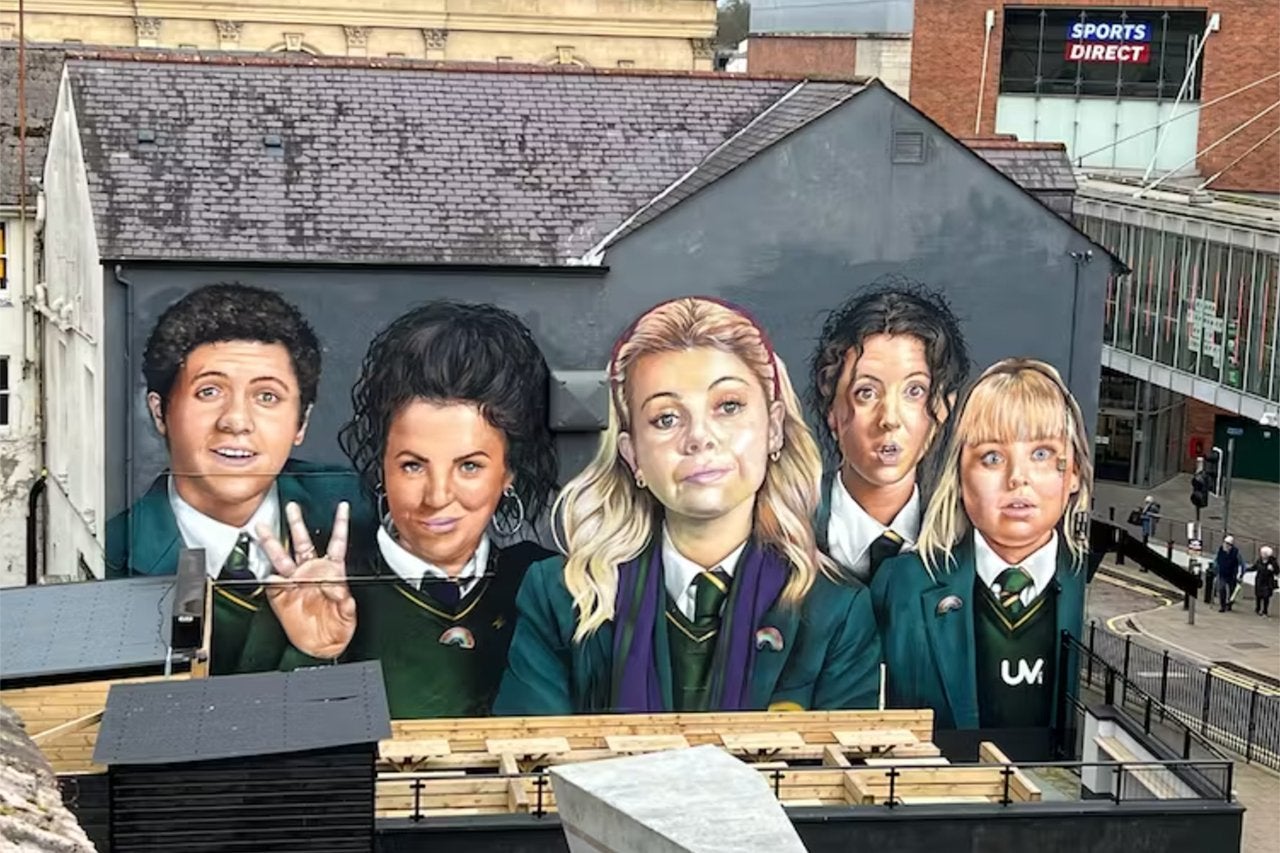Above: A mural in Derry commemorating the TV show ‘Derry Girls,’ which follows the lives of teenagers growing up amid Northern Ireland’s troubles. (Photo by Dominic Bryan, CC BY-NC-ND)
Originally published in

By Joseph Patrick Kelly, director of Irish and Irish American Studies
A 9-year-old boy lies on the floor of a working-class rowhouse in Belfast, Northern Ireland, wondrously watching American Westerns on TV. Outside, though, the world’s gone mad. Broken glass and shattered masonry. Barricades go up. Rifle-toting soldiers patrol the streets.
It’s August 1969, the summer that Northern Ireland’s ‘troubles’ flared into violence.
The scene is from “Belfast,” director Kenneth Branagh’s ode to growing up in the grinding conflict that would go on to kill several thousand people. Branagh’s Academy Award-winning film premiered in 2021, more than two decades after the Good Friday Agreement brought the troubles to a close on April 10, 1998 – 25 years ago this month.
This was the second period of so-called troubles in Ireland. The first involved a bloody guerrilla war that ended in 1921, with the island partitioned into an independent, mostly Catholic south and a mostly Protestant north that remained part of the United Kingdom.
But that division did little to settle the age-old war of cultural identity. Since then, each generation of artists has used theater, song and film to reflect on their states’ still-uneasy peace – made all the more complicated by Brexit.
‘Four green fields’
For hundreds of years, British culture stereotyped the “native” Irish as savage, bestial, childlike, lazy, belligerent and, above all else, unruly: a tribe that needed British civilization – and, therefore, its colonization. Irish nationalists like poet W.B. Yeats, who wanted to free the whole of Ireland from British rule, felt they had to flip this script by purging the island of “Anglo” influences, reviving the Irish language and promoting Celtic arts.
In 1902, Yeats wrote the masterpiece of this Celtic revival, “Cathleen ni Houlihan.” The one-act play dramatizes traditional songs and legends about a poor old woman driven from her farm by strangers. Cathleen recruits a groom – on the eve of his wedding day, no less – to help fight to retrieve her “four beautiful green fields.”

A scene from ‘Cathleen ni Houlihan.’ (Project Gutenberg/Wikimedia Commons)
It’s an obvious allegory: She is Ireland, the fields are Ireland’s four provinces, and the strangers are the British. The blood of Irish martyrs nourishes the old woman, and at the play’s end, Cathleen transforms into a young girl “with the walk of a queen.”
Cultural pride helped fuel support for Irish independence, and the Irish Republican Army drove the British out of three of the island’s four provinces by 1922. But a majority of people in much of the final province, Ulster, identified as British, so a new national border was drawn to separate the two communities.
That gerrymandered border sparked a civil war in the new Irish Free State between the “die-hard” nationalists, who wanted to keep fighting the British till they abandoned the north, and the “Free Staters,” who compromised to make peace. Martin McDonagh’s 2022 film “The Banshees of Inisherin,” nominated for nine Academy Awards, can be viewed as an allegory of the Irish Civil War – the tragedy when brothers in arms turn their guns on one another.
Spiraling crisis
Many Protestants loyal to the U.K. viewed the culture of Northern Ireland’s minority Catholic population as a threat and treated them as second-class citizens. In the late 1960s, in part inspired by Martin Luther King Jr.‘s civil rights activism in the U.S., Catholics began campaigning against discrimination. Their demands were met with violence, like the 1972 Bloody Sunday massacre, in which British soldiers shot and killed 14 unarmed protesters in Derry, also known as Londonderry – rival names that themselves reflect the sharp divide between communities.

Tribal feelings spiraled higher, pitting mostly Protestant “unionists” loyal to the U.K. against Catholic “nationalists” who sought reunion with the Republic of Ireland. Neighborhoods were segregated and giant walls went up to keep Catholic and Protestant apart, but wave after wave of reprisals came anyway, including bombings and sniper attacks.
As the troubles intensified, folk musician Tommy Makem’s popular song “Four Green Fields” drew again on the legend of Ireland as a poor old woman:
“I have four green fields, one of them’s in bondage
In strangers’ hands, that tried to take it from me
But my sons have sons as brave as were their fathers
My fourth green field will bloom once again,” said she.
It became a nationalist battle call, and a sign of the times, as plenty of young men joined the IRA’s campaign against British control of Northern Ireland.
Nowhere was the “them and us” attitude more evident than on the gable ends of rowhouses, where nationalists and unionists each painted murals celebrating their heroes and remembering the atrocities perpetrated by the other side.

‘Sing a new song’
In the mid-1970s, a group of writers and actors, including the Nobel laureate poet Seamus Heaney, tried to blaze a way out of this cultural death spiral. Calling themselves “Ireland’s Field Day,” they tried to create art that could be a “fifth province” of Ireland, a place that would transcend sectarian politics.
U2 wrote its hit song “Sunday, Bloody Sunday,” the first song on its 1983 album “War,” in the same spirit. It begins with images reminiscent of the massacre in Derry 11 years before:
Broken bottles under children’s feet
Bodies strewn across the dead-end street
In U2’s telling, the villain is not the other side. The enemy is the violence itself, generated by the feedback loop of Nationalism and unionism. The only way out is to refuse “to heed the battle call.”
The album ends with the song “40,” a soulful echo of the Bible’s 40th Psalm: “I will sing … sing a new song.”
This kind of thinking helped lead the war-weary people of Northern Ireland to the Good Friday Agreement, also called the Belfast Agreement, in 1998. Its deals shaped the power-sharing system Northern Ireland has today, which legitimizes both identities. People in Northern Ireland can choose to be citizens of the U.K., citizens of the Republic of Ireland, or both.

It has, by and large, worked. Over the years, this commitment to religious, political and racial equality tamped down the tribalism and violence. The border between Ireland and Northern Ireland became less and less relevant. By 2018, half of the people in Northern Ireland described themselves as “neither nationalist nor unionist.”
A new generation
Brexit, however, has turned the line between Ireland and Northern Ireland into the only land border between the U.K. and the EU. Both nationalist and unionist identities are on the uptick, and the proportion of people in Northern Ireland claiming neither identity has plummeted to 37%.
Even so, anthropologist Dominic Bryan, co-chair of Northern Ireland’s Commission on Flags, Identity, Culture, and Tradition, is optimistic that culture has built up a resistance to “us versus them” tribalism – reflected, in part, by how people remember the troubles.
He sent me a picture of a mural in Derry, painted one year after Brexit, which celebrates Lisa McGee’s hit TV show “Derry Girls.” Launched in 2018, the comedy follows the fictional lives of five teenagers growing up in the troubles. Though the show focuses on a Catholic community, it defuses the “us and them” way of thinking about identity. An episode called “Across the Barricades” satirizes facile attempts to get Catholic and Protestant kids to bond; it ends when they recognize their common enemy: parents.
In the last episode of the first season, while the kids deal with the anxieties of a high school talent show, the tone shifts dramatically. The adults are watching a TV news report of “one of the worst atrocities of the Northern Irish conflict.” A bomb has killed 12 people and injured many more, and “anyone with medical training” is urged to “come to the scene immediately.”
The audience doesn’t know if the bomb was detonated by Catholic terrorists or Protestant terrorists. It doesn’t matter. The violence is like a tornado or an earthquake: a disaster suffered by all of Derry’s citizens, who pick up the pieces together.![]()
Joseph Patrick Kelly, Professor of Literature and Director of Irish and Irish American Studies, College of Charleston
This article is republished from The Conversation under a Creative Commons license. Read the original article.




